
| Arthropoda |  |
Xiphosura |
| Arthropoda | Xiphosura |
| Page Back | Unit Back | Metazoa | Dendrogram | References | Taxon Index | Pieces |
| Page Next | Unit Next | Unit Home | Dendrogram | References | Glossary | Time |
Chelicerata |--Merostomata | |--Xiphosura | | |--Bunodidae | | `--+--Bellinurina | | `--Limulina | | |--Paleolimulidae | | `--Limulidae | `--+--Chasmataspida | `--Eurypterida `--Arachnida |
Taxonomy Contents Remarks Evolution Systematics Basal Xiphosura Weinberginidae Bunodidae Xiphosurida Bellinurina Limulina Paleolimulidae Limulidae Links & References |
Class Xiphosura Latreille, 1802
(Horseshoe crabs and their extinct relatives)
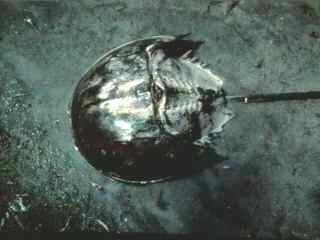
Introduction to the Xiphosura
Phylogeny
Systematics
Order Synziphosurida
family Weinberginidae
family Bunodidae
family Pseudoniscidae
family Kasibelinuridae
Order Xiphosurida
superfamily Bellinuroidea (including Euproopacea)
family Bellinuridae
family Euproopidae
family Elleriidae
superfamily unspecified
family Rolfeiidae
superfamily Limuloidea
family Paleolimulidae
family Moravuridae
family "Valloisellidae"
family Austrolimulidae
family Heterolimulidae
family Limulidae
Links
There are only 3 genera and 5 species of Xiphosura left alive today, but they were much more numerous and diverse during the Palaeozoic era. The surviving horseshoe crabs (Limulus) are 'living fossils', barely changed in some 250 million years (since early Triassic time). Members of this class have a large shield that covers the cephalothorax; the carapace is hinged between the cephalothorax and abdomen. The exoskeleton generally consists of three parts, the large, semicircular cephalothorax, or prosoma, the usually smaller, subtriangular and in earlier forms "trilobite"-like opisthosoma, and the long stout tail-spine or telson (which is actually the end part of the opisthosoma).
The prosoma contains both head and visceral organs. The compound eyes are small (and absent in some early forms), and there are six pairs of legs (in the living Limulus) but no antennae. The second pair of appendages, the pedipalps, resemble walking legs. Respiration is via 5 pairs of book gills, the flaps of which beat in a metachronal rhythm to produce a vigorous current. Recent xiphosurids (Horseshoe crabs) feed on worms and other small invertebrates. They are often used as laboratory animals by physiologists. It has been argued that because of their unique status as prehistoric "living fossils" they deserve special conservation status.
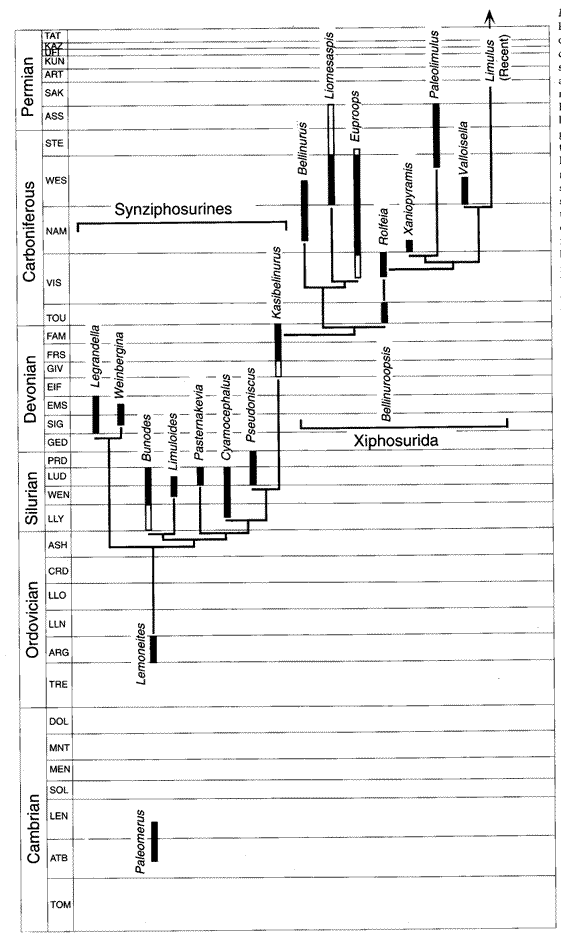
The Evolution of the Xiphosura during the Paleozoic era, showing representative genera. This cladogram is from Anderson & Selden, reproduced courtesy Lyall Anderson.
Paleomerus and Lemoneites are very early forms that were either Aglaspids or transitional between the Aglaspida and the Xiphosura. The Furongian (Caerfai epoch) marine family Eolimulidae is generally considered a true Xiphosuran, but again more research needs to be done if more is to be known about the early history of this interesting group.
There are only two orders (or sub-orders, depending on your preference) of Xiphosura, the primitive and ancestral Synziphosurina/-ida, and the Lumulina/-ida/Xiphosurida/-ina. The latter group includes modern horseshoe crabs and their immediate ancestors.
The Aglaspida, for a long time considered a very primitive order of Xiphosura, are now thought to be a distinct group, and may actually be closer in fact be closer to the trilobites, or alternatively an ancestral lineage of Merostomata. The Chasmataspida, previously considered Xiphosura, appear to be closer to the Eurypterida, or possibly represent an independent subclass. With modern cladistic analysis even this Linnean arrangement is being discarded.
The following family level Linnean classification presented here is a sort of compromise between the Treatise of Invertebrate Paleontology, the Fossil Record I and II, and the recent work of ![]() Lyall Anderson (who presents a
cladistic arrangement of the group). In view of the fact that this material is taken hither-thither from other sources it should not be considered an authoritative review of the group.
Lyall Anderson (who presents a
cladistic arrangement of the group). In view of the fact that this material is taken hither-thither from other sources it should not be considered an authoritative review of the group.
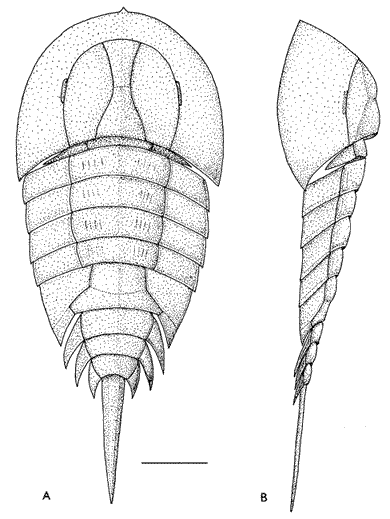
The Synziohosurida are a small, fairly diverse, paraphyletic / ancestral group of primitive Xiphosura. Rather trilobite-like in appearance. Large prosoma (headshield), simple eyes only. 9 or 10 opisthosomal (abdominal) segments, most or all of which are free (unfused). The segments are not chelate. Mostly brackish or freshwater environments, although some forms were marine (marginal marine?). Usually found in association with eurypterids and ostracoderms.
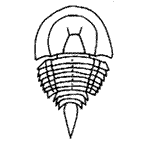 Family Weinberginidae Richter and Richter, 1929
Family Weinberginidae Richter and Richter, 1929
Small elongate forms, ornamented prosoma, abdomen with broad axis, 9 free segments, post-abdomen with 3 or 4 segments.
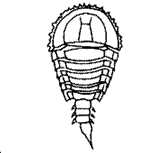 new ranking; formerly family Limuloididae Størmer, 1952
new ranking; formerly family Limuloididae Størmer, 1952
 new ranking; family Bunodidae Packard 1886
new ranking; family Bunodidae Packard 1886
 family Pseudoniscidae Packard 1886
family Pseudoniscidae Packard 1886
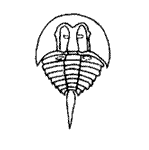 Family Kasibelinuridae Pickett, 1993
Family Kasibelinuridae Pickett, 1993
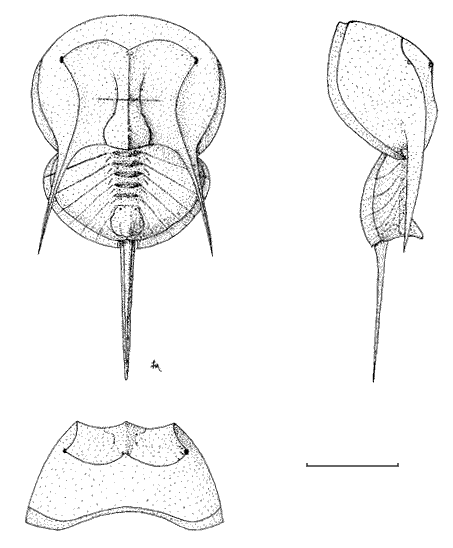
The Order Xiphosurida/Limulida includes most Xiphosura, and all post-Devonian forms. These animals were quite common during the Carboniferous, and some forms seem to have been amphibious, although other types (e.g. Paleolimulus) were fully marine. Beginning from small ancestral types they increased in size through the Mesozoic and Cenozoic, and modern horseshoe crabs are giants compared to Paleozoic forms (the horse also has shown a similira tendency to increase in size but reduce in diversity throughout the Tertiary and Quaternary periods), There is the tendency towards fusion of the opisthosomal tergites (free abdominal segments) to form a thoracetron or fused plate. There are several superfamilies and a greater number of families, but only one lineage made it into the post-Paleozoic world. Cladistic analysis so far indicates that the Xiphosurida are a monophyletic taxon.
Anderson and Selden consider the Bellinuroidea a suborder (Bellinurina) which contains only two families, the Bellinuridae and the Euproopidae. His Euproopidae would seem to be equivalent to the Treatise's Euproopacea, as it includes the genera Euproops and Liomesaspsis (usually each put in a seperate family of the Euproopacea). These were small animals, with short bodies, only partially fused abdominal segments, and wide rounded horseshoecrab-like headshields, giving them a rather trilobite-like resemblence, apart from the long tail-spine or telson. They frequented the coal swamps and were in all likelihood amphibious, perhaps living part of their life-cycle on land.
time range: Frasnian
habitat: Marginal Marine ? Brackish and Fresh water. Amphibious?
representative taxa:
description: Abdominal axis and pleural area segmented; the rear of the abdominal shield deeply indented. In the Treatise placed in the superfamily Euproopacea. In view of the early date this group may perhaps turn out to be a
separate early off-shoot.
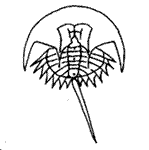 Family Euproopidae Eller, 1938 (junior synonym: family Liomesaspidae Raymond 1944
Family Euproopidae Eller, 1938 (junior synonym: family Liomesaspidae Raymond 1944
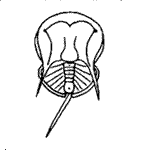 Taxanomic note: In the Treatise this family is separated from the Bellinuridae by being placed in the superfamily Euproopacea. Liomesaspis is placed in the family Liomesaspidae, superfamily Euproopacea, and there is also a seperate listing for the family in the Fossil Record II (time range: Bashkirian to Asselian). However Anderson and Selden include Liomesaspis in the family Euproopidae, and Anderson points out that Raymond's initial diagnosis of Liomesaspidae as lacking axial furrows does not apply to the specimens of the genus he has studied. There seems no reason therefore in retained it as a valid family.
Taxanomic note: In the Treatise this family is separated from the Bellinuridae by being placed in the superfamily Euproopacea. Liomesaspis is placed in the family Liomesaspidae, superfamily Euproopacea, and there is also a seperate listing for the family in the Fossil Record II (time range: Bashkirian to Asselian). However Anderson and Selden include Liomesaspis in the family Euproopidae, and Anderson points out that Raymond's initial diagnosis of Liomesaspidae as lacking axial furrows does not apply to the specimens of the genus he has studied. There seems no reason therefore in retained it as a valid family.
 Family Bellinuridae Zittel and Eastman, 1913
Family Bellinuridae Zittel and Eastman, 1913
The Limulina represent the most advanced lineage of the group, descended from early Carboniferous transitional forms like Rolfeia. The cephalothorax is wide and arched, with the cardiophthalmic region poorly defined. . The abdominal segments are usually fully fused, although the marginal spines are movable. Includes the 5 living species of "horseshoe crabs" (Limulus). These creatures live in a shallow marine environment (although some Paleozoic forms may have been brackish water inhabitants). Jurassic Xiphosurids are extremely similar to those found today.
Anderson and Selden distinguish between the superfamily Paleolimuloidea - defined by the pyramidal cheek node on the carapace - and the superfamily Limuloidea (which Includes all Mesozoic and Cenozoic Xiphosura).
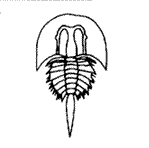 Rolfeiidae Selden and Siveter, 1987
Rolfeiidae Selden and Siveter, 1987
These are paraphyletic basal limulines.
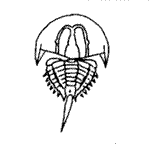 Family Paleolimulidae Raymond, 1944
Family Paleolimulidae Raymond, 1944
time range: Serpukhovian
habitat: Marginal Marine
representative taxa: Xaniopyramis linseyi Siveter and Selden, 1987
Probably a branch of the Paleolimulidae
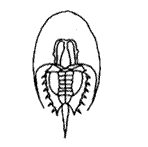 time range: Bashkirian to Moscovian
time range: Bashkirian to Moscovian
This, and the following two families are staem limulids, of uncertain
monophyly.
 In the Treatise this taxon is considered a subfamily.
In the Treatise this taxon is considered a subfamily.
| Links and References |
![]() Xiphosura - Horseshoe crabs presents the best general introduction to the group on the Web
Xiphosura - Horseshoe crabs presents the best general introduction to the group on the Web
![]()
![]()
![]() Lyall I. Anderson's Home Page - excellent material on
Paleozoic Xiphosura, and heaps of links
Lyall I. Anderson's Home Page - excellent material on
Paleozoic Xiphosura, and heaps of links
![]() Anderson,
LI (1997), The xiphosuran Liomesaspis from the Montceau-les-Mines Konservat Lagerstatte, Massif Central,
France. N. Jahrb. Geol. Palaontol., Abh. 204: 415-436.
Anderson,
LI (1997), The xiphosuran Liomesaspis from the Montceau-les-Mines Konservat Lagerstatte, Massif Central,
France. N. Jahrb. Geol. Palaontol., Abh. 204: 415-436. ![]() abstract
abstract
![]() Anderson,
LI (1998), A new specimen of the Silurian synziphosurine Cyamocephalus.
Proc. Geol. Assoc. 110: 211-216.
Anderson,
LI (1998), A new specimen of the Silurian synziphosurine Cyamocephalus.
Proc. Geol. Assoc. 110: 211-216. ![]() abstract
abstract
![]() Anderson,
LI & PA Selden (1997), Opisthosomal fusion and phylogeny of Palaeozoic
Xiphosura. Lethaia 30: 19-31.
Anderson,
LI & PA Selden (1997), Opisthosomal fusion and phylogeny of Palaeozoic
Xiphosura. Lethaia 30: 19-31. ![]() abstract
abstract
![]()
![]() Euproops
danae, from the Mazon Creek deposits of Illinois (Moscovian age)
Euproops danae was a small form, length about 2 cm, that is relatively common in the Mazon Creek deposit. It seems to have been freshwater or even semiaquatic, living part of its life on land
Euproops
danae, from the Mazon Creek deposits of Illinois (Moscovian age)
Euproops danae was a small form, length about 2 cm, that is relatively common in the Mazon Creek deposit. It seems to have been freshwater or even semiaquatic, living part of its life on land
| Page Back | Page Top | Unit Home | Page Next |
page uploaded 7 May 2002
checked ATW080326
page text Creative Commons Attribution M. Alan Kazlev
last modified ATW060225
this material may be freely used as long as attribution is given